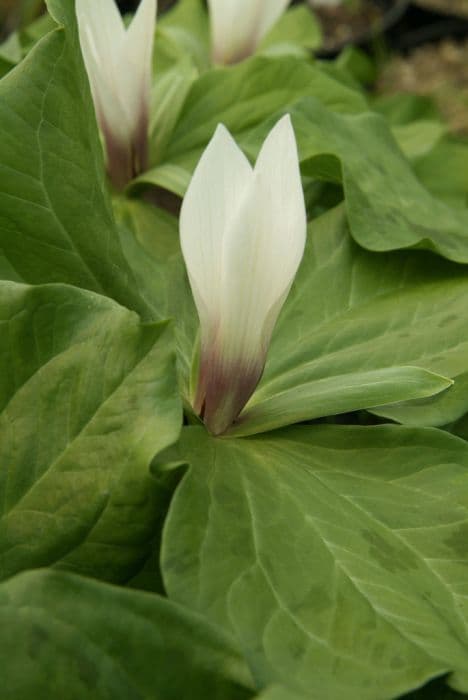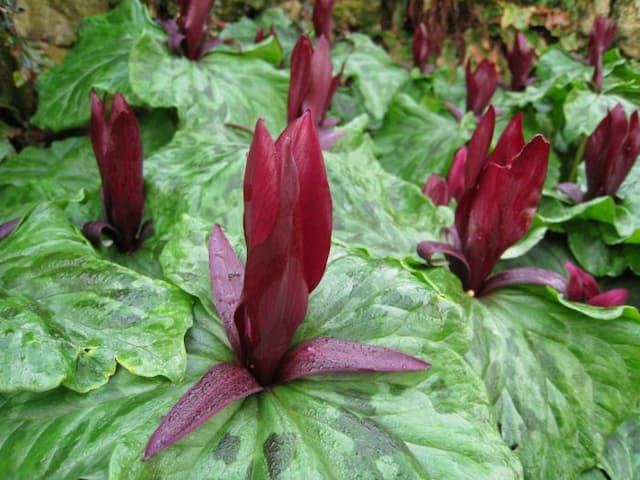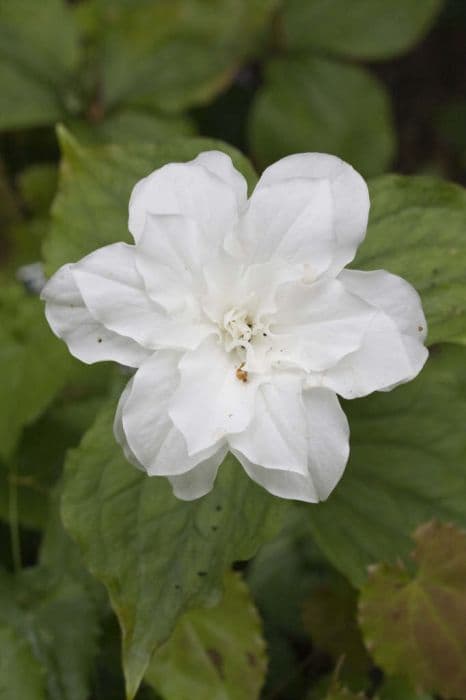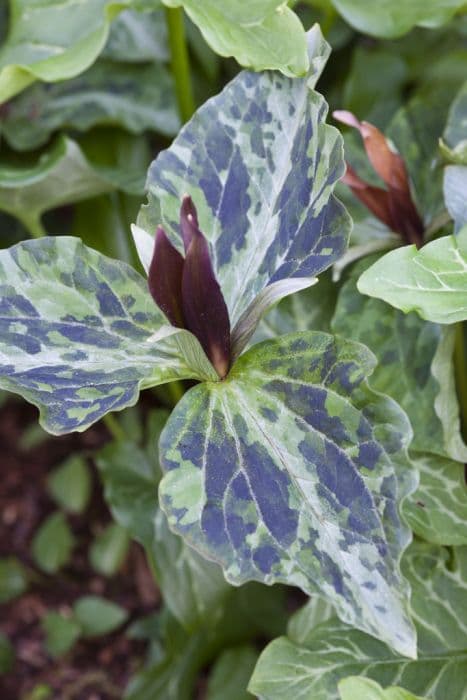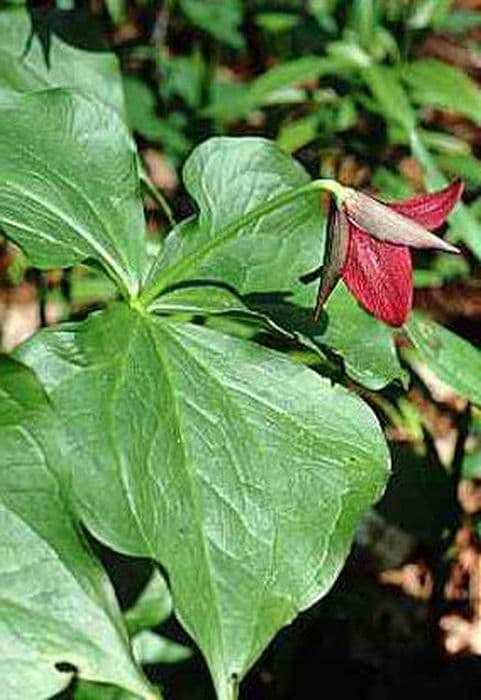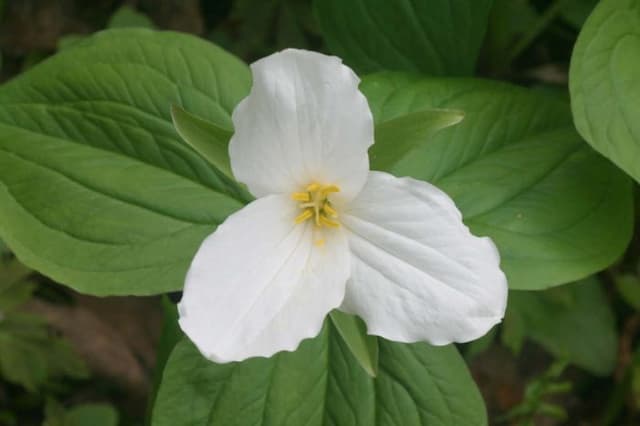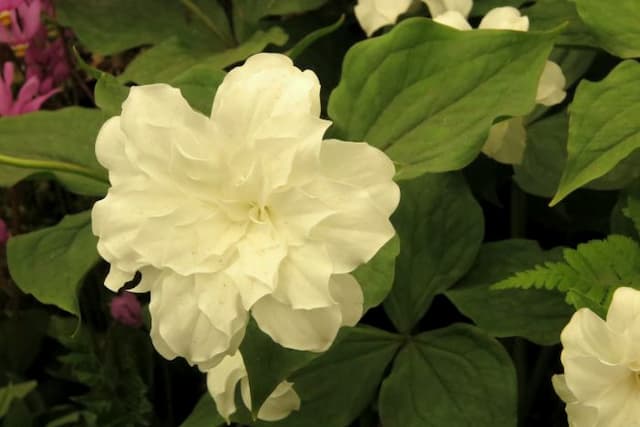Toadshade Trillium sessile

ABOUT
The plant known as Toadshade or Sessile Trillium is a fascinating woodland perennial that adds a unique charm to shaded gardens. This plant is characterized by a trio of broad, flat leaves that are deeply green and often mottled with shades of maroon or dark green, giving them a variably patterned appearance. At the center of this leafy base, a single, unusual flower emerges. Unlike some of its relatives with elevated blooms, Toadshade's flower sits directly atop the leaves, close to the ground, which is where its name "sessile" derives from, indicating its lack of a flower stalk. The blossom itself is quite striking, generally composed of three petals that can vary in color from deep burgundy to maroon, though occasionally they may be a greenish-yellow. The petals are often recurved, curling back slightly from the center of the flower. These colorful petals surround a set of three stamens which are prominently visible and give the flower an intriguing texture and appearance against the forest floor backdrop. Underneath the flower, there are three sepals, which tend to be green and blend in with the surrounding foliage. Toadshade's beauty is not just in its flowers but also in the geometric aesthetic provided by its leaves and their arrangement. The symmetry of three leaves and three petals is a distinctive feature of this plant, a pattern that remains consistent and easily recognizable. The leaves are not only a backdrop for the flower but also an integral part of the plant’s allure, often playing with the light that filters through the canopy above and casting interesting shadows on the ground beneath. This perennial is a true shade-loving specimen, flourishing in the cool, moist environments of wooded areas where it can often be found in clusters, creating a lush, green carpet dotted with its unique, low-sitting blossoms during the spring season.
About this plant
 Names
NamesFamily
Melanthiaceae
Synonyms
Toadshade, Sessile Trillium, Red Trillium, Sessile Wake-Robin, Toad Trillium
Common names
Trillium sessile, Trillium viride, Trillium nivale var. sessile, Trillium sessile var. viride.
 Toxicity
ToxicityTo humans
The plant commonly known as toadshade is not typically considered toxic to humans. While it is not generally regarded as edible and should not be consumed, there is no well-documented evidence of significant toxicity or poisoning from toadshade. However, as with any non-culinary plants, ingesting parts of toadshade could potentially cause mild stomach upset or an allergic reaction in some individuals. It is always best to avoid ingesting plants that are not identified as safe for human consumption.
To pets
The plant commonly known as toadshade is not known to be toxic to pets. There is limited information regarding its effects after being ingested by animals such as dogs or cats, but it is not listed among the commonly recognized toxic plants for pets. As with humans, ingestion of non-edible plants by pets should be avoided as it may cause gastrointestinal upset or an allergic reaction. If a pet does consume toadshade and shows any signs of illness, it is advisable to consult a veterinarian.
 Characteristics
CharacteristicsLife cycle
Perennials
Foliage type
Deciduous
Color of leaves
Green
Flower color
Maroon
Height
1 foot (30 cm)
Spread
1 foot (30 cm)
Plant type
Herb
Hardiness zones
5
Native area
North America
Benefits
 General Benefits
General Benefits- Ecological Support: Toadshade provides nectar and pollen for native bees and other pollinating insects, which in turn supports local biodiversity.
- Habitat Restoration: As a native species, planting Toadshade can help restore natural habitats and maintain ecological balances.
- Erosion Control: The root systems of Toadshade can help to stabilize soil, thus preventing erosion in woodland areas.
- Aesthetic Appeal: With its distinctive maroon flowers and broad leaves, Toadshade contributes to the visual appeal of shade gardens and naturalized areas.
- Wildlife Food Source: The seeds of Toadshade are eaten by ants and other wildlife, forming an integral part of woodland food webs.
- Education and Research: Toadshade can be used for educational purposes, helping students and researchers learn about native plant species and woodland ecology.
- Cultural Significance: Trilliums, including Toadshade, often have cultural and historical significance, and can be an important aspect of regional identity and heritage.
- Garden Diversity: Including Toadshade adds diversity to a garden, which is key to a healthy and resilient plant community.
 Medical Properties
Medical Properties- Antispasmodic: Trillium sessile has been historically used to relieve spasms.
- Diuretic: It has properties that promote the increased production of urine.
- Parturifacient: The plant has been traditionally used to aid in childbirth.
- Antiseptic: It’s used for its ability to help prevent infection.
 Air-purifying Qualities
Air-purifying QualitiesThis plant is not specifically known for air purifying qualities.
 Other Uses
Other Uses- Toadshade's leaves can be used for creating natural green dyes, providing color to fabrics and materials using traditional dyeing methods.
- As a subject in photography, Toadshade often contributes to forest floor compositions due to its unique shape and the contrast it creates against the brown leaf litter.
- Garden enthusiasts sometimes use Toadshade as a means to identify the health of the forest ecosystem, as it tends to grow in undisturbed habitats.
- Individuals who practice nature-based crafts might incorporate Toadshade into pressed flower art due to its interesting structure and aesthetic appeal.
- Toadshade serves as a food source for native wildlife, especially deer, which find the plant palatable in early spring when other food sources are scarce.
- During Native American ceremonies or educational demonstrations, Toadshade might be used to help explain the rich biodiversity of woodland ecosystems.
- Some local communities have used Toadshade in their initiatives or programs to promote awareness about endangered plant species and the importance of habitat conservation.
- Ecotourism guides include Toadshade in their educational materials when showcasing the variety of plant life in specific woodland regions to tourists.
- Toadshade can be used as a natural insect repellent, with some gardeners planting it to deter certain pests from more delicate plants or vegetables.
- In floral arrangements, wildflower enthusiasts may use fresh or dried Toadshade to add a unique and native touch to bouquets and centerpieces.
Interesting Facts
 Feng Shui
Feng ShuiThe Toadshade is not used in Feng Shui practice.
 Zodiac Sign Compitability
Zodiac Sign CompitabilityThe Toadshade is not used in astrology practice.
 Plant Symbolism
Plant Symbolism- Purity: As a wildflower often spotted in woodland areas, the sessile trillium typically symbolizes purity due to its gentle and unblemished appearance.
- Beauty: The trillium is widely recognized for its beauty, particularly the striking symmetry of its three petals.
- Elegance: With its simple yet captivating structure, the sessile trillium represents elegance in the natural world.
- Recovery and Healing: Given that trilliums are perennial plants that return after harsh winters, they are seen as symbols of recovery and healing.
- Trinity: The three leaves and petals of the sessile trillium are often associated with the concept of trinity in several cultures, which can represent various triads such as mind, body, and spirit.
 Water
WaterToadshade, or Trillium sessile, prefers consistent moisture, especially during spring and summer growth periods. Water the plant once a week with about 1 inch of water, which is roughly equivalent to 0.5 gallons, depending on soil conditions and climate. During the hot seasons, you may need to water twice a week if the soil dries out quickly. In the dormant winter months, reduce watering significantly, only ensuring that the soil doesn't become completely dry. Always check the top few inches of soil for moisture before watering to avoid over-saturation.
 Light
LightToadshade thrives best in dappled sunlight or partial shade, mimicking its native woodland habitats. It should be placed in a location where it can receive filtered light through the canopy of larger trees or in a spot that gets morning sunlight but is shaded during the intense heat of the afternoon. Full shade is also acceptable, as too much direct sunlight can scorch its leaves.
 Temperature
TemperatureToadshade is hardy and can survive in a temperature range from approximately 35°F to 85°F. Nonetheless, the ideal temperature range for promoting optimal growth is between 50°F and 75°F. The plant may go dormant if temperatures drop below freezing or during the heat of the summer if not adequately shaded and watered.
 Pruning
PruningToadshade does not require regular pruning, but deadheading the spent flowers after they fade can promote a tidier appearance. Pruning is not necessary for plant health but can be done to remove damaged or discolored foliage. The best time for any minor pruning would be in late fall or early spring before new growth begins.
 Cleaning
CleaningNot needed
 Soil
SoilToadshade, commonly known as Trillium sessile, thrives in a rich, well-draining soil mix with plenty of organic matter such as leaf mold or compost. The best soil pH for toadshade is slightly acidic to neutral, ranging between 6.0 and 7.0. A mix of two parts garden soil, one part sand, and one part peat or compost would make a suitable soil environment for the healthy growth of this woodland perennial.
 Repotting
RepottingToadshade generally does not require frequent repotting and can be left undisturbed for several years. This plant often prefers to grow in naturalized woodland settings where it can spread slowly over time. If grown in a container, repotting every 2-3 years is sufficient to refresh the soil and provide space for gradual root expansion.
 Humidity & Misting
Humidity & MistingToadshade flourishes in an environment that simulates its native woodland habitat, which means it prefers high humidity. The ideal humidity level for toadshade is between 60% and 70%, but it will tolerate a range with some flexibility, as long as the soil moisture and shade conditions are adequate.
 Suitable locations
Suitable locationsIndoor
Keep toadshade in bright, indirect light with high humidity and cool temps.
Outdoor
Plant toadshade in partial shade, rich soil, and in a moist, cool spot.
Hardiness zone
4-9 USDA
 Life cycle
Life cycleToadshade, or Trillium sessile, begins its life as a seed, typically dispersed by ants through a process known as myrmecochory. Once the seed germinates, it develops into a small rhizome, which will lie dormant underground until conditions are right for growth. The following spring, a single shoot emerges from the rhizome, bearing a whorl of three leaves and usually a single, stalkless flower. The flower then matures, taking on its characteristic maroon color, and is pollinated by insects attracted to its scent and color. After pollination, the flower develops into a berry-like fruit, which when ripe, is again dispersed by animals. The plant continues this cycle seasonally, going dormant in the winter and re-emerging in the spring, with the rhizome gradually growing larger and sometimes producing more than one shoot as the plant ages.
 Propogation
PropogationPropogation time
Spring
Propogation: Trillium sessile, commonly known as the toadshade or sessile trillium, is typically propagated by seed. The most popular method of propagation for this plant involves collecting the seeds after the fruit has ripened, which usually occurs in late summer or early fall. These seeds contain a fleshy structure called an elaiosome, which attracts ants that help with dispersal. Once collected, the seeds must undergo a period of cold stratification to break dormancy; this mimics the natural winter conditions that the seeds would experience in their native habitat. To achieve this, the seeds can be mixed with moist sand and stored in a refrigerator at about 40 degrees Fahrenheit (4.44 degrees Celsius) for three months. After cold stratification, the seeds can be sown in a well-draining soil mix and kept in a shaded place until germination, which may take up to two years.
